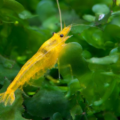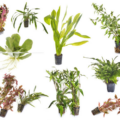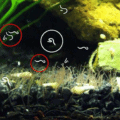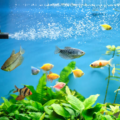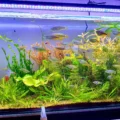After overcoming the initial hurdles of setting up your first aquarium, you begin to notice a strange yet compelling force that beckons you to buy another tank.

With time, this obsession spreads out to the open and you suddenly begin contemplating what types of small pond fish to include in your water garden.
Sound familiar?
Well, if it does, then you’re at the right place.
I’ve compiled a list of the best hardy fish species for an outdoor pond.
As an added bonus, I’ve also included some tips that will help your fish survive the harsher months of the year.
14 Small Pond Fish for an Impressive Water Garden
If you’ve ever kept a freshwater aquarium, then you’ll find some of the entries on this list familiar.
Unlike other aquarium species, these fish are hardy enough to survive a wide range of water temperatures, which makes them perfect for an outdoor pond or water garden.
The remaining species aren’t as popular because they’re better suited for life outdoors and wouldn’t bode well in an indoor aquarium.
Regardless of this, each of the species on this list will enable you to create a stunning outdoor water garden that’s worthy of envy. Take a look at the 14 small fish that will help you create an impressive garden pond:
1. Umbrella Cichlid – Apistogramma Borellii
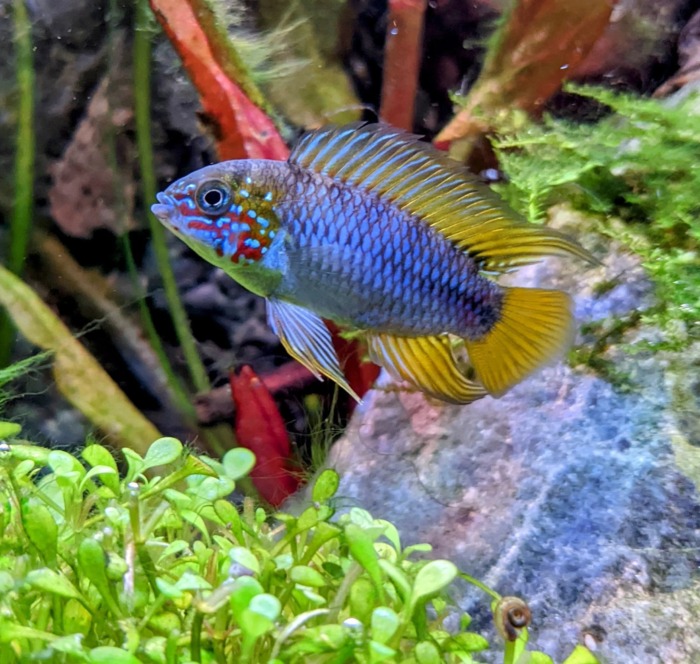
by mimimimimi2
| Maximum size: | 2.5 inches (6.5 cm) |
| Diet: | Detritivorous; also eat mosquito larvae, cyclops, artemia, daphnia, and mysis. |
| Temperature range: | 68 – 82.4 °F (20 – 28 °C) |
Umbrella cichlids (Apistogramma borelli) can be an interesting addition to a small outdoor pond thanks to their shimmery scales and peaceful nature. Males grow to be about 2.5 inches and females reach approximately 2 inches.
They tend to grow relatively rapidly, reaching full size within a few months.
Even though they’re tropical fish, Umbrella cichlids can withstand temperature drops down to 53 °F, making them suitable for temperate climates.
2. Fancy Tail Guppy – Poecilia Reticulata
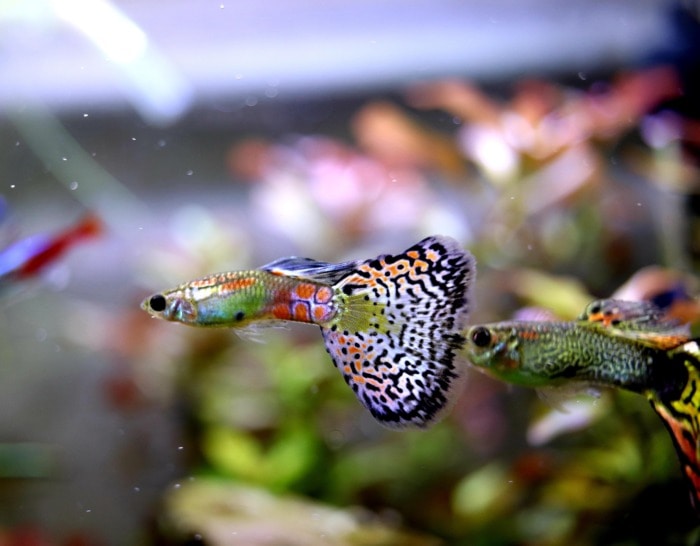
by b6chen
| Maximum size: | 2.5 inches (6.35 cm) |
| Diet: | Omnivorous; mosquito larvae are a favorite, but plant matter is necessary for their diets. |
| Temperature range: | 55 – 86 °F (13 – 30 °C) |
Fancy tail guppies (Poecillia reticulata) are the smallest species on this list, growing to a maximum of 2.5 inches within about six months. What they lack in size, however, they make up for with flashy colors, landing them a spot on my list of 36 colorful freshwater fish.
They tolerate temperatures from 55 °F up to 86 °F but prefer being kept at a temperature range between 72 to 82 °F.
3. Central Stoneroller – Campostoma anomalum

by BDR58
| Maximum size: | 6 inches (15.24 cm) |
| Diet: | Herbivorous; their preferred food is algae |
| Temperature range: | 41 – 65 °F (5 – 18.33 °C) |
Central stonerollers (Campostoma anomalum) are cold water minnows that have a strong taste for algae.
In fact, these fish survive on a diet that’s almost entirely based on algae in the wild.
Adding them to your pond will not only enhance its appeal but also keep algae growth at bay.
However, in order to reap the benefits of these fish, you should first provide them with a sufficient water flow and a clean environment.
If you manage to do this, you’ll be able to enjoy their company for years to come.
4. Paradise Fish – Macropodus opercularis

by random-donut-
| Maximum size: | 4 inches (10 cm) |
| Diet: | Omnivorous; they will consume any types of small fish, insect, or aquatic animal they can fit in their mouths, and will also eat any vegetable matter that makes it into the pond. |
| Temperature range: | 61 – 79 °F (16 – 26 °C) |
The vibrant mix of colors of the Paradise fish (Macropodus opercularis) makes it one of the most popular species in the aquarium hobby. Fortunately, you can experience their beauty in an outdoor pond as well.
This is because they tolerate a wide range of temperatures and aren’t as picky as Central Stonerollers when it comes to cleanliness.
Paradise fish can afford the luxury to tolerate messy environments, thanks to a specialized organ that lets them suck oxygen straight from the air.
They will reach their full size of up to 4 inches in a few months, though most are usually closer to 3 inches.
5. Sailfin Molly – Poecilia latipinna
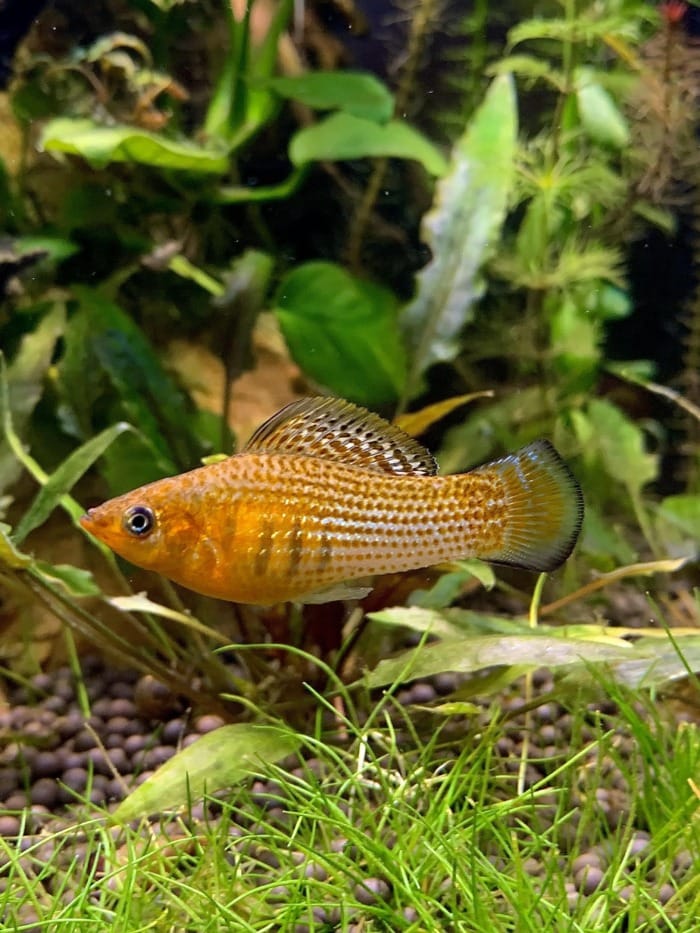
by CactusJuiceIsQuenchy
| Maximum size: | 5 inches (12.5 cm) |
| Diet: | Herbivorous; they enjoy algae and other plant material. |
| Temperature range: | 68 – 82 °F (20 – 28 °C) |
Sailfin mollies (Poecilia latipinna) can be an impressive addition to a pond, provided you take some key information into consideration.
These fish don’t appreciate water cooler than 68 ° F and may need to be brought inside for the winter if your climate is cooler than this.
Sailfin mollies are quite small and prefer to live in large schools. They reach their adult size of up to 5 inches within a year, and will quickly populate the water if the water parameters are right.
6. Siamese Algae Eater – Crossocheilus oblongus
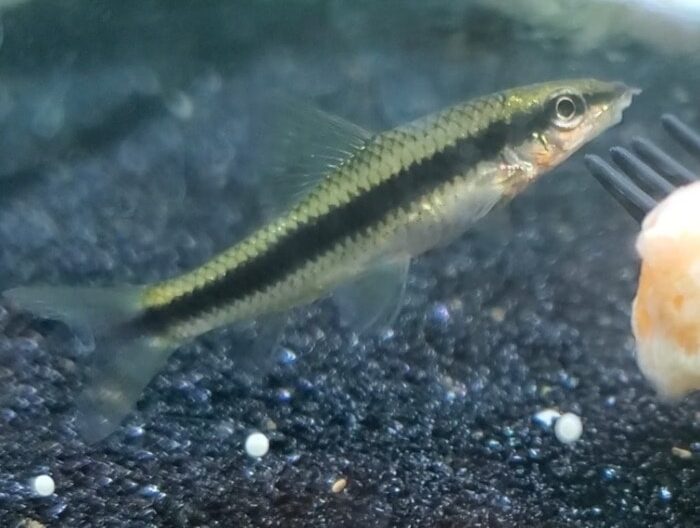
by RoseTeeco
| Maximum size: | 6 inches (16 cm) |
| Diet: | Omnivorous; most of their nutrients come from algae and other plant matter, but they also eat insects and dead fish. |
| Temperature range: | 70 – 80 °F (21 – 27 °C) |
Siamese algae eaters (Crossocheilus oblongus) are phenomenal fish to control algae growth in a garden pond thanks to their insatiable algae-eating appetites. These cleaning fish can grow up to 6 inches within a period of two years if they’re kept happy and healthy.
Unfortunately, these fish don’t tolerate cold temperatures, so if you live in an environment with colder outdoor waters, you’ll need to add a heater or bring them in during the colder months.
7. Green Swordtail – Xiphophorus hellerii
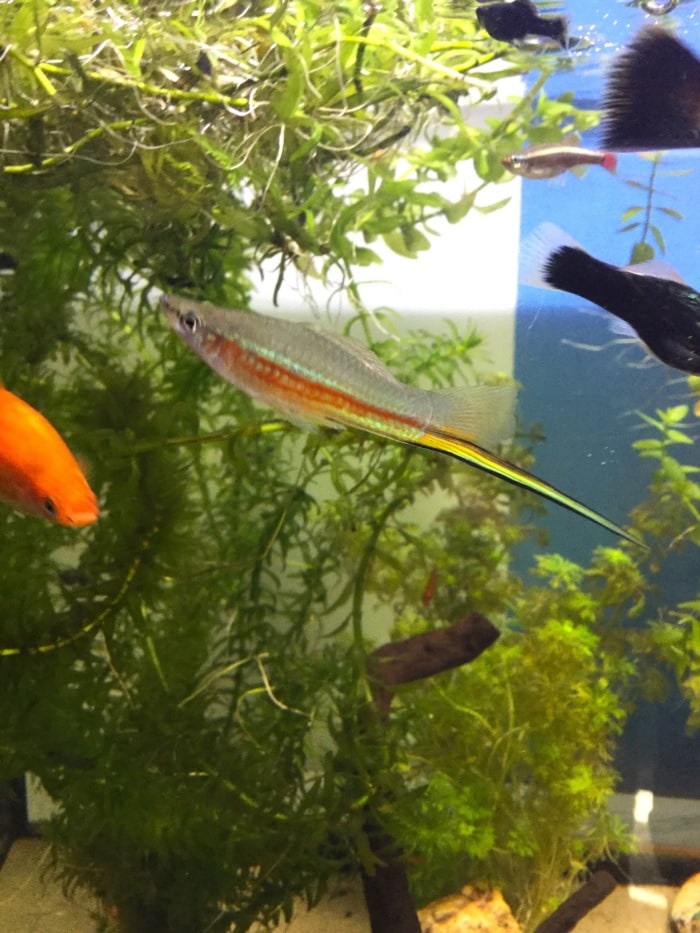
by Salty&Onion
| Maximum size: | 6 inches (16 cm) |
| Diet: | Omnivorous; it prefers plants, crustaceans, insects, and worms. |
| Temperature range: | 65 – 82 °F (18 – 28 °C) |
Green swordtails (Xiphophorus hellerii) are livebearer fish that thrive in outdoor ponds with warm water temperatures.
To get the best out of them, you should keep them in a temperature range between 65 to 82 °F.
Depending on your climate region, you can create a strong strain of swordtails by letting them reproduce during the winter.
This way, you’ll weed out the weaker specimens and end up with a strain that can survive colder temperatures.
8. Orange Spotted Sunfish – Lepomis humilis

by Dfitz
| Maximum size: | 5.9 inches (15 cm) |
| Diet: | Omnivorous; they prefer insects, fish, and crustaceans, but will also eat plant matter. |
| Temperature range: | 65 – 70 °F (18 – 21 °C) |
Orange spotted sunfish (Lepomis humilis) create an interesting addition to water gardens with their brightly colored scales.
They are native to the United States, which makes them a great choice for many US ponds.
Orange-spotted sunfish are predators that feed on larvae, zooplankton, and small fish. As a result of their dietary habits, these fish have an elongated body and a round snout.
The maximum size for these fish is about 6 inches, though most are closer to 5 inches.
They are slower growers than most of the other fish on this list, reaching about 1 inch during their first year.
If you want to stock your small pond with sunfish you can choose between various species from AZ Gardens’ online collection of pond fish.
9. Florida Flagfish – Jordanella floridae
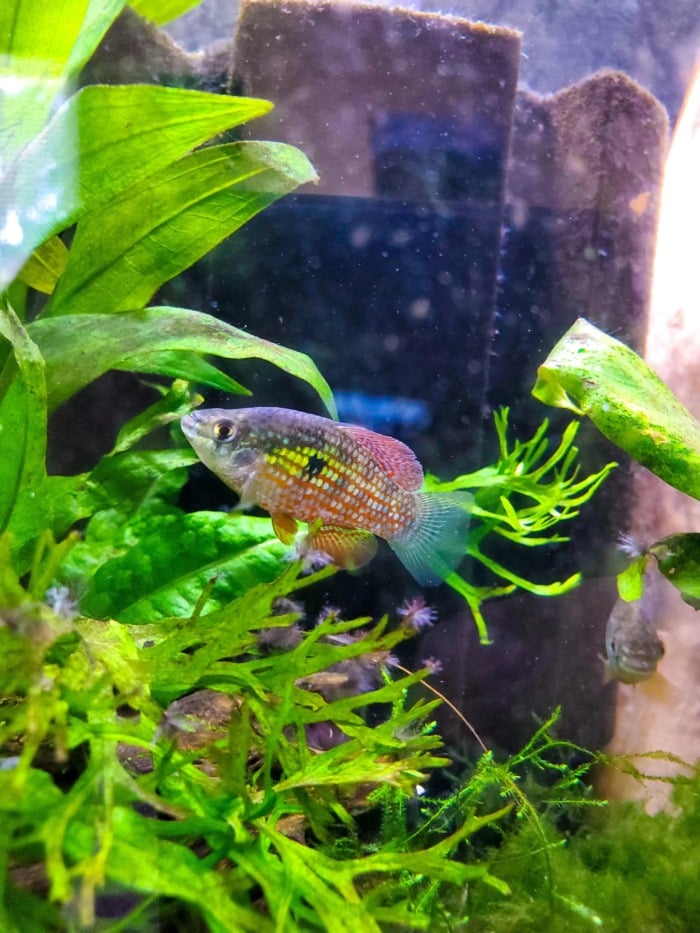
by AggressiveFigs
| Maximum size: | 2.5 inches (6.35 cm) |
| Diet: | Omnivorous; the bulk of their diet comes from algae and plant matter, but they also enjoy insects and shrimp. |
| Temperature range: | 64 – 86 °F (18 – 30 °C) |
Florida flagfish (Jordanella floridae), are an algae-eating fish, named after their resemblance to the American flag.
They’re found mostly in cold waters but can survive warmer temperatures as well.
Their ability to tolerate a wide range of temperatures lets them easily adapt to pond life, especially during the summer months.
These mini pond fish grow to 2.5 inches and will breed nearly continuously as long as the water stays warm enough.
Their measly size of Florida flagfish also makes them good for small ponds.
10. Mosquitofish – Gambusia affinis

by cv123
| Maximum size: | 4 inches (10 cm) |
| Diet: | Omnivorous; They primarily eat mini insects, including mosquito larvae, but do eat small amounts of algae. |
| Temperature range: | 50 – 84 °F (10 – 29 °C) |
Mosquitofish (Gambusia affinis) devour massive amounts of wildlife insects like mosquito larvae, hence their name. This makes them great at reducing mosquito populations which reduces the spread of diseases carried by these insects.
These fish thrive in cooler waters and are perfectly content to swim in a pond that gets down to 50 ° F.
Males are noticeably smaller than females, growing half the size at 1.5 inches while females can be as big as 4 inches.
They reach maturity within 4-5 months.
11. Comet Goldfish – Carassius auratus
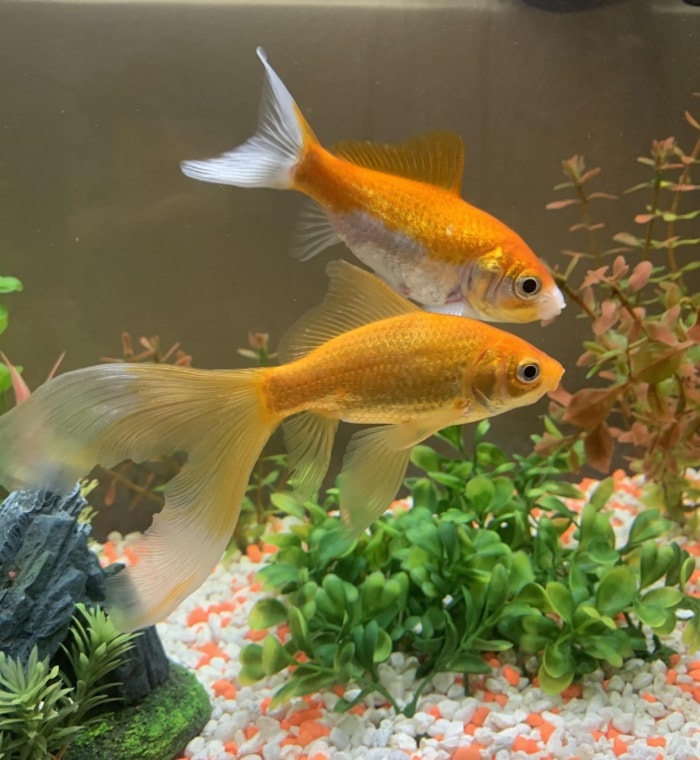
by haleighbird
| Maximum size: | 14 inches (35 cm) |
| Diet: | Omnivorous; they enjoy a mix of larvae, insects, invertebrates, and plant matter. |
| Temperature range: | 39 – 68 °F (4 – 20 °C) |
The comet goldfish (Carassius auratus) is the most common goldfish breed due to its resilience. The innate hardiness of the comet goldfish helps it survive staggering temperature drops, which makes it the best cold water fish for a small pond.
As a result of their popularity in the aquarium hobby, these fish are also extremely cheap.
Comet goldfish also come in a variety of colors which can let you create a colorful goldfish pond.
You can choose from colors such as orange, silver, white and yellow.
I’ve had the opportunity of witnessing a goldfish pond once, and it was an amazing sight to behold.
The entire pond seemed like an ever-shifting vortex of colors!
A good place to look for comet goldfish is the PondMegaStore website.
12. Fathead Minnow – Pimephales promelas

| Maximum size: | 4 inches (10 cm) |
| Diet: | Omnivorous; these fish are opportunistic feeders and will eat just about anything they can get into their mouths. |
| Temperature range: | 59 – 89 °F (15 – 32 °C); Can survive temperature drops to 32 °F |
The fathead minnow (Pimephales promelas) is native to North America and can survive a diverse range of water parameters.
They reproduce rapidly when the water is warm enough, with females spawning up to 4,000 eggs each year.
These tiny fish prefer temperatures between 59-89 °F but can survive just fine even when the pond water is freezing.
They grow somewhat quickly, reaching full size by two years old.
13. Shubunkin

by nelliemay5
| Maximum size: | 14 inches (35 cm) |
| Diet: | Omnivorous; they eat just about anything they can fit in their mouths. |
| Temperature range: | 36 – 90 °F (4 – 32 °C) |
Shubunkin (Carassius auratus auratus) are related to comet goldfish, but tend to have calico coloration and longer fins.
They are an artificial breed of fish, created in Japan as a crossbreed of Calico telescope goldfish and Comet goldfish.
Unlike the plain coloration of their ancestors, Shubunkins have a distinct white coat that’s overlaid with black, blue, and orange markings.
These fish are slow growers but live up to 30 years when well cared for.
You can expect them to grow around 1 inch per year.
14. Bantam Sunfish – Lepomis symmetricus
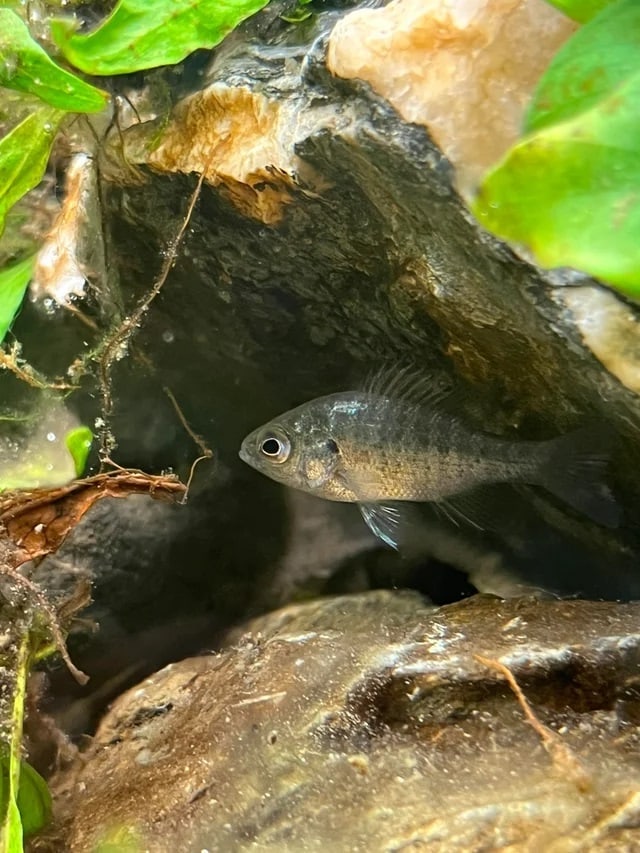
by theRemRemBooBear
| Maximum size: | 3.5 inches (9 cm) |
| Diet: | Carnivorous; they prefer snails, microcrustaceans, and insects. |
| Temperature range: | 68 – 86 °F (20 – 30 °C) |
Bantam sunfish (Lepomis symmetricus) isn’t a commonly known fish in the aquatics hobby, but they can be sourced through pond stockers.
They are typically found in some regions of the USA and Mexico, where they inhabit areas with dense vegetation.
These fish are rather short-lived as they have an average lifespan of just three years.
Regardless of this, they do well in outdoor ponds year-round, enjoying temperatures between 68 – 86 °F.
How to help your pond fish survive the winter?
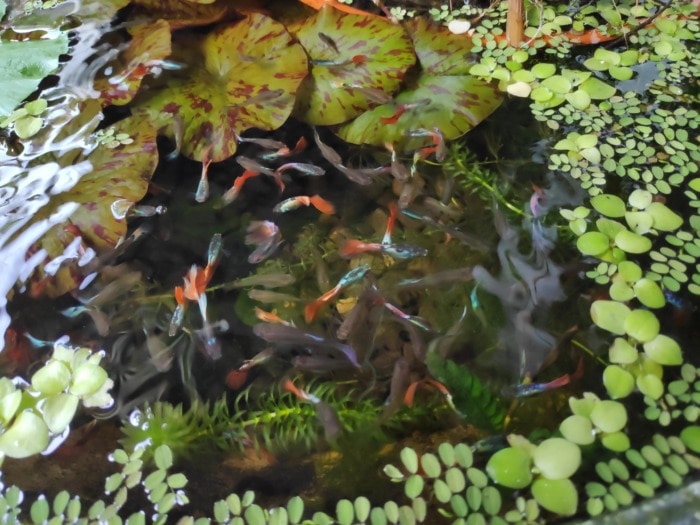
by arafdi
Winter can be a stressful time for new pond owners as they worry about colder temperatures.
As long as you’ve chosen fish that can tolerate cold water and taken precautions with those that don’t, your pond fish should survive just fine.
Even if the pond freezes over, the fish will go dormant.
Here are some of the tips I’ve used to foster a pond ecosystem that can survive winter:
- Make Your Pond Deep Enough
Deeper ponds will help fish survive, and if your pond is too shallow, your fish may struggle.
Hardy goldfish and koi, for example, need at least 4 feet of water depth to overwinter well.
Deeper ponds also allow for proper winter stratification, meaning the top of the water will freeze while your fish will still have liquid water at the bottom.
- Use an Aerator or Small Recirculating Pump
To help keep oxygen in the water, you can use a small recirculating pump or an aerator to keep the water moving.
Just make sure you don’t put them on the bottom of the pond, as this can disrupt the gradual change in temperature of the water.
I’ve had luck sticking a pump on a rock or shelf on the side of the pond.
- Surface Heaters and De-icers
You need to keep a hole in your ice so gas exchanges can continue, even when the water freezes over.
Inline heaters or boilers can stop the water from freezing by turning on when water falls beneath a certain temperature threshold.
This is a good option for fish that won’t tolerate winter temperatures well or if you live somewhere that is extra cold.
I’ve found that one of the most important steps in preparing for winter is to clean before it begins.
Anything that will decompose in the water over the winter can use up dissolved oxygen during the process and raise the ammonia concentration to dangerous levels.
Water in the winter months already has less dissolved oxygen because there’s less surface area for gas transfer and oxygenating vegetation dies off.
Cleaning out any muck or leaves at the bottom of the pond and doing a water change before water freezes helps prepare your pond to survive through winter.
As it gets colder, fish metabolisms slow down and they don’t need as much food.
Once waters hit under 50 °F, stop feeding them until spring.
Tropical and subtropical fish generally don’t do well in the winter when left outside.
Bring in fish that don’t like their water to get too cold and let them spend winters warm and toasty inside.
Ice and snow actually help to insulate your pond to prevent water temperature fluctuations.
Leave most of it on the surface, leaving a few small holes for gas exchanges.
My Closing Thoughts
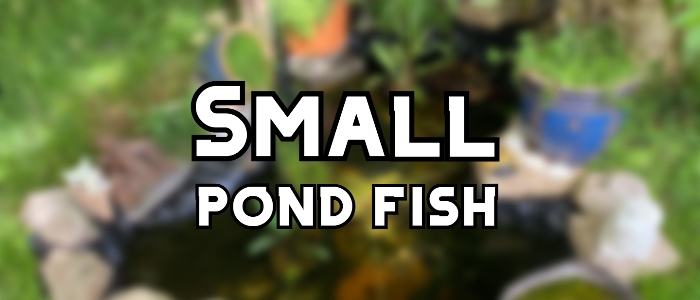
Freshwater ponds make a great addition to outdoor gardens, but learning how to stock them can be a bit of a learning curve.
In this list, I’ve introduced several species that will do well for beginners.
Some are fish that eat algae to help keep the water clean.
Others, like goldfish, can simply be a pleasure to watch from your patio.
By following the tips listed, you should be well on your way to success with keeping your own pond.


